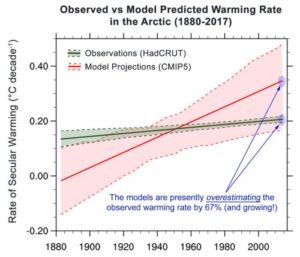by Nature, February 21, 2020
Bubbles in Antarctic ice suggest that warming will not result in massive release of long-buried methane.
Runaway global warming driven by the release of methane from the Arctic seems less likely than some scientists have feared.
Methane and its components can be locked up for millennia in permafrost — a frozen mixture of soil and ice — and in deposits of crystal-like structures called methane hydrates. Methane released by modern organic materials contains a form of carbon that methane from ancient sources does not, allowing scientists to distinguish between the two types.
Michael Dyonisius at the University of Rochester in New York and his colleagues analysed Antarctic ice cores to determine the origins of methane released during a warming period that ended the last ice age. The warming raised global temperature by roughly 4ºC — slightly more than the rise projected to occur by 2100 in most scenarios of human-induced climate change.
The team’s results suggest that methane emissions during that big thaw were dominated by emissions from wetlands, not by the release of ancient methane from melting permafrost and methane hydrates. The authors conclude that modern climate change is unlikely to trigger a massive release of ancient methane.
by Craig Idso, February 26, 2020 in ClimateChageDispatch
Paper Reviewed:
Huang, J., Ou, T., Chen, D., Lun, Y. and Zhao, Z. 2019. The amplified Arctic warming in recent decades may have been overestimated by CMIP5 models. Geophysical Research Letters 46: 13,338-12,345.
Policies aimed at protecting humanity and the environment from the potential effects of CO2-induced global warming rely almost entirely upon models predicting large future temperature increases.
But what if those predictions are wrong? What if a comparison between model projections and observations revealed the models are overestimating the amount of warming?
Would climate alarmists admit as much and back away from promoting extreme policies of CO2 emission reductions?
Probably not — at least based upon the recent rhetoric of each of the candidates seeking the Democrat Party’s nomination for President of the United States, all of whom continue to call for the complete elimination of all CO2 emissions from fossil fuel use within the next three decades, or less.
But for non-ideologues who are willing to examine and accept the facts as they are, the recent work of Huang et al. (2019) provides reason enough to pause the crazy CO2 emission-reduction train.
In their study, the five researchers set out to examine how well model projections of Arctic temperatures (poleward of 60°N) compared with good old-fashioned observations.
More specifically, they used a statistical procedure suitable for nonlinear analysis (ensemble empirical mode decomposition) to examine secular Arctic warming over the period 1880-2017.
Observational data utilized in the study were obtained from the HadCRUT4.6 temperature database, whereas model-based temperature projections were derived from simulations from 36 Coupled Model Intercomparison Project Phase 5 (CMIP5) global climate models (GCMs).

Figure 1. Observed and model-predicted rates of nonlinear, secular warming in the Arctic (60-90°N) over the period 1880-2017. The black and red dashed lines indicate the 10th and 90th percentiles for temperature means. Adapted from Huang et al. (2019).
As indicated there, the model-estimated rate of secular warming (the solid red line) increased quite sharply across the 138 year period, rising from a value of around 0°C per decade at the beginning of the record to a value of 0.35°C per decade in the end.
…
by Die Kalte Sonne & P. Gosselin, February 26, 2020 in ClimateChangeDispatch
…
19th century glacier retreat in the Alps preceded the emergence of industrial black carbon deposition on high-alpine glaciers
Light absorbing aerosols in the atmosphere and cryosphere play an important role in the climate system. Their presence in ambient air and snow changes the radiative properties of these systems, thus contributing to increased atmospheric warming and snowmelt. High Spatio-temporal variability of aerosol concentrations and a shortage of long-term observations contribute to large uncertainties in properly assigning the climate effects of aerosols through time.
Starting around AD 1860, many glaciers in the European Alps began to retreat from their maximum mid-19th century terminus positions, thereby visualizing the end of the Little Ice Age in Europe. Radiative forcing by increasing deposition of industrial black carbon to snow has been suggested as the main driver of the abrupt glacier retreats in the Alps. The basis for this hypothesis was model simulations using elemental carbon concentrations at low temporal resolution from two ice cores in the Alps.
Here we present sub-annually resolved concentration records of refractory black carbon (rBC; using soot photometry) as well as distinctive tracers for mineral dust, biomass burning and industrial pollution from the Colle Gnifetti ice core in the Alps from AD 1741 to 2015. These records allow precise assessment of a potential relation between the timing of observed acceleration of glacier melt in the mid-19th century with an increase of rBC deposition on the glacier caused by the industrialization of Western Europe. Our study reveals that in AD 1875, the time when rBC ice-core concentrations started to significantly increase, the majority of Alpine glaciers had already experienced more than 80 % of their total 19th-century length reduction, casting doubt on a leading role for soot in terminating of the Little Ice Age. Attribution of glacial retreat requires expansion of the spatial network and sampling density of high alpine ice cores to balance potential biasing effects arising from transport, deposition, and snow conservation in individual ice-core records.”
Also, a glacier history of the Alps since the end of the last ice age was published in 2009 by Susan Ivy-Ochs and colleagues.
Between 10,500-3300 years before today, glaciers were mostly smaller than today and ended 200 meters above modern levels. The Alpine glaciers expanded during the cold period of migration and the Little Ice Age.
Want to know more about glacier history? Here’s the abstract:
…
La géologie, une science plus que passionnante … et diverse

